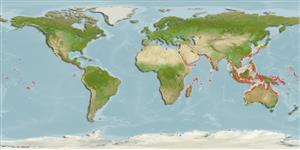Elasmobranchi (squali e razze) (sharks and rays) >
Myliobatiformes (Stingrays) >
Gymnuridae (Butterfly rays)
Etymology: Gymnura: Greek, gymnos = naked + Greek, oura = tail (Ref. 45335).
More on author: Shaw.
Environment: milieu / climate zone / depth range / distribution range
Ecologia
marino demersale; distribuzione batimetrica ? - 80 m (Ref. 9773). Tropical
Indo-Pacific: Persian Gulf (Ref. 68964), Red Sea to French Polynesia, north to Japan. Also reported from Persian Gulf (Ref. 96002).
Length at first maturity / Size / Peso / Age
Maturity: Lm 48.0 range ? - ? cm
Max length : 250 cm WD maschio/sesso non determinato; (Ref. 30573)
Ovoviviparous (Ref. 50449). Caught often in demersal trawls, and occasionally by trammel net. Utilized for its meat, but of limited value due to its typically small size (Ref. 58048).
Exhibit ovoviparity (aplacental viviparity), with embryos feeding initially on yolk, then receiving additional nourishment from the mother by indirect absorption of uterine fluid enriched with mucus, fat or protein through specialised structures (Ref. 50449). Distinct pairing with embrace (Ref. 205). Gives birth to litters of up to 7 pups; born at 24-26 cm WD (Ref. 58048).
Sommer, C., W. Schneider and J.-M. Poutiers, 1996. FAO species identification field guide for fishery purposes. The living marine resources of Somalia. FAO, Rome. 376 p. (Ref. 30573)
IUCN Red List Status (Ref. 130435: Version 2024-1)
Threat to humans
Harmless
Human uses
Pesca: commerciale
Strumenti
Special reports
Download XML
Fonti Internet
Estimates based on models
Preferred temperature (Ref.
123201): 25.2 - 29.2, mean 28.5 °C (based on 2718 cells).
Phylogenetic diversity index (Ref.
82804): PD
50 = 0.5000 [Uniqueness, from 0.5 = low to 2.0 = high].
Bayesian length-weight: a=0.00617 (0.00391 - 0.00973), b=3.06 (2.92 - 3.20), in cm total length, based on LWR estimates for this species & (Sub)family-body (Ref.
93245).
Trophic level (Ref.
69278): 3.8 ±0.59 se; based on food items.
Resilienza (Ref.
120179): Molto basso, tempo minimo di raddoppiamento della popolazione più di 14 anni (Fec=1-6).
Fishing Vulnerability (Ref.
59153): Moderate vulnerability (43 of 100).
Nutrients (Ref.
124155): Calcium = 18.6 [5.1, 96.5] mg/100g; Iron = 0.633 [0.154, 1.772] mg/100g; Protein = 22.5 [19.0, 25.4] %; Omega3 = 0.159 [0.044, 0.512] g/100g; Selenium = 54.2 [15.2, 177.9] μg/100g; VitaminA = 9.18 [3.08, 26.74] μg/100g; Zinc = 0.584 [0.276, 1.078] mg/100g (wet weight);
